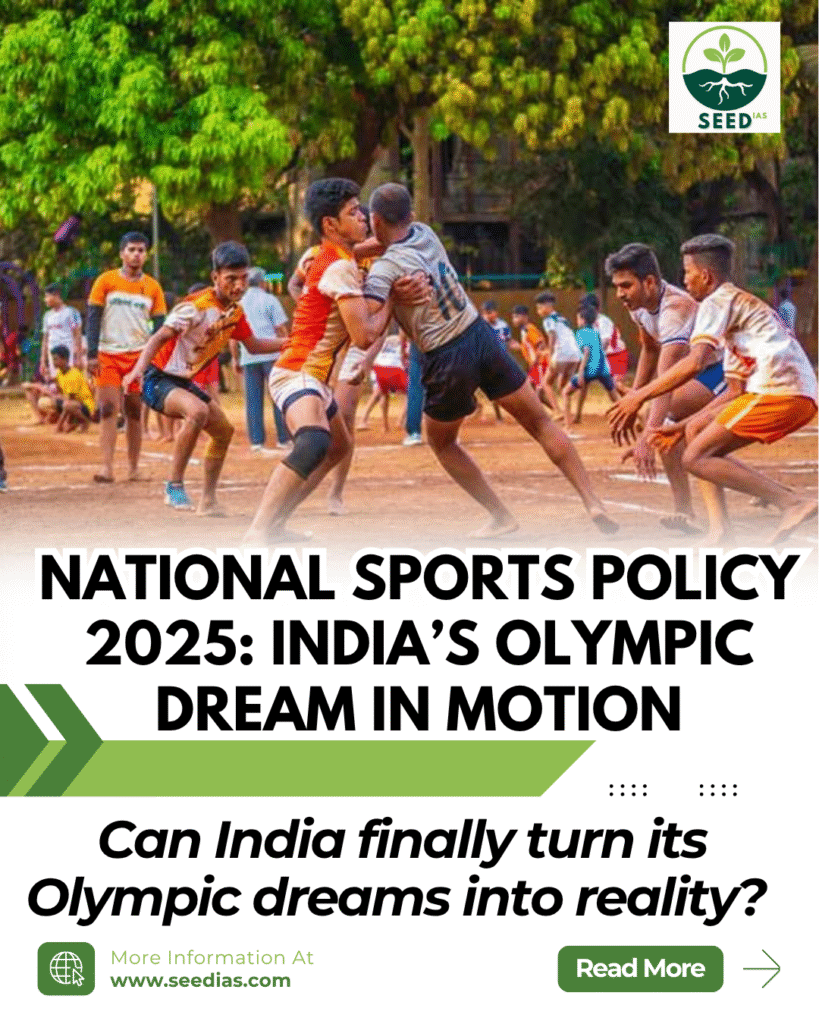Why in NEWS
The Union Cabinet has approved the National Sports Policy (NSP) 2025, replacing the two-decade-old 2001 policy. It aims to transform India into a global sporting powerhouse with a strategic focus on the 2036 Olympics.
Key Terms & Concepts
| Term | Explanation |
|---|---|
| NSP 2025 | National Sports Policy 2025 – a comprehensive framework to overhaul India’s sports ecosystem. |
| Khelo India | A government initiative to identify and nurture sports talent at grassroots level. |
| TOPS | Target Olympic Podium Scheme – support system for elite athletes. |
| NSFs | National Sports Federations – bodies governing specific sports in India. |
| Fit India Movement | A campaign promoting fitness and active lifestyles. |
| Sports Authority of India (SAI) | Nodal agency implementing sports programs and training athletes. |
Key Pillars of NSP 2025
| Pillar | Focus |
|---|---|
| Global Sporting Excellence | Early talent identification, professional leagues, upgraded coaching, sports science integration, and improved NSF governance. |
| Sports for Economic Development | Boost sports tourism, startups, and private investments to build a robust sports economy. |
| Sports for Social Development | Promote inclusion of marginalized communities, revive indigenous games, and enhance community engagement. |
| Mass Participation & Fitness | Encourage a fitness culture through campaigns and universal access to sports infrastructure. |
| Education Integration | Align with NEP 2020 to embed sports into the school curriculum and train educators. |
| Governance & Tech Framework | Ensure transparency, use AI/data tools, set KPIs, and offer model policies for states. |
Evolution of India’s Sports Policy
| Phase | Key Developments |
|---|---|
| Post-Independence | Hosted Asian Games (1951), created AICS (1954), hockey dominance, limited funds and infrastructure. |
| 1980s–2000 | First National Sports Policy (1984), SAI created (1986), policy integration with education, uneven implementation due to limited budgets. |
| Post-Liberalisation | Increased visibility via cable TV, draft policies proposed but not enacted. |
| 21st Century | NSP 2001 launched, SAI expanded, TOPS (2014) and Khelo India (2017) initiated, but elite success remained limited. |
| Pre-NSP 2025 Context | Scattered reforms, budget increases, governance issues persist, prompting a major overhaul. |
Challenges in India’s Sports Ecosystem
| Challenge | Explanation |
|---|---|
| Poor Governance | Politicisation, ethical failures (e.g., WFI case), suspension of IOA, and inadequate support for athletes. |
| Cricket Dominance | 87% of the sports economy is cricket-centric, leaving other sports underfunded. |
| Limited Representation | Olympic delegations remain small despite India’s large population. |
| Weak Talent Pipeline | Absence of structured scouting mechanisms; rural talent often missed. |
| Gender Gaps | High dropout among girls, abuse and safety concerns, lack of equal infrastructure and opportunities. |
| Academic Pressure | Sports not prioritized as a career; schools often discourage active sports participation. |
Proposed Measures for Sports Promotion
| Measure | Strategy |
|---|---|
| Grassroots Scouting | Launch structured rural/tribal scouting; model after Australia’s physiological tests. |
| Infrastructure Expansion | Build inclusive sports centres at district/block levels; integrate sports in higher education. |
| Governance Reform | De-politicise NSFs; appoint professionals; ensure transparency. |
| Gender Inclusion | Gender audits, equal pay, safe environments, and anti-abuse policies aligned with UNESCO guidelines. |
| Tech & Science Adoption | Use AI, wearables, sports labs for Olympic training; adopt global best practices. |
| Cultural Shift | Mass campaigns, regular school/state leagues, and promote sports as a viable career. |
| Monitoring System | Set KPIs, dashboards, and audits for evaluating policy outcomes at all levels. |
In a Nutshell
Mnemonic: S-T-R-I-D-E
Scouting, Technology, Reforms, Inclusion, Development, Education
NSP 2025 is a bold step to reshape India’s sports landscape. But its success depends on deep reforms, empowered institutions, and sustained grassroots investments. The 2036 Olympics could be India’s moment—if the policy translates into action.
Prelims Practice Questions
- Which of the following is not a pillar of the National Sports Policy 2025?
A. Sports for Economic Development
B. Sports for Political Representation
C. Sports for Social Development
D. Sports as a People’s Movement - Consider the following pairs:
- Target Olympic Podium Scheme – Mass participation in schools
- Khelo India – Grassroots sports promotion
- Fit India Movement – Fitness awareness campaign
Which of the pairs are correctly matched?
A. 1 and 2 only
B. 2 and 3 only
C. 1 and 3 only
D. All of the above
- Which of the following organizations is responsible for implementing India’s sports development schemes?
A. Indian Olympic Association
B. National Sports Federations
C. Sports Authority of India
D. Ministry of Education
Mains Questions
- Critically examine the challenges in India’s sports governance system. How can the National Sports Policy 2025 address them? (GS2: Governance)
- Discuss how India can leverage its demographic dividend and digital tools to transform into a global sporting powerhouse. (GS3: Development & Technology)
Prelims Answer Key and Explanations
| Qn | Answer | Explanation |
|---|---|---|
| 1 | B | “Sports for Political Representation” is not a pillar; the other three are key NSP 2025 pillars. |
| 2 | B | TOPS is for elite athletes, not mass participation. Khelo India and Fit India are correctly matched. |
| 3 | C | Sports Authority of India is the nodal body for implementing development programs. |
















